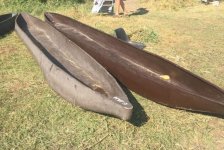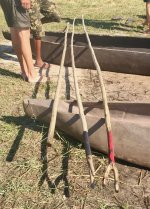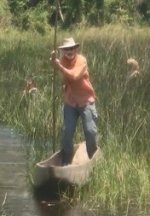I've been touring around over in Africa. Our tour included a trip into the Okavango delta. Unfortunately, I was just another client on our trip, meaning our boat (makoro) was poled by a Botswanian. I hate it when somebody else drives the boat, but, that's the way the tour was set up.
Traditionally, the makoro was a dugout made from a single large tree. Now, using trees for makoros is viewed as environmentally unsustainable, and the government of Botswana mandated the people switch over to fiberglass. They make the glass boats in the traditional shape of a dugout log. The boats are roughly six meters long and roughly a bit over a half meter wide, with no thwarts.

For poles, they use saplings stripped of their bark. They are not too smooth either, with burrs where the branches used to be that dug into my hands. Some are forked, and some of the forks are wired together to keep them from splitting. Some of them are wrapped with a piece of steel near the bottom, to help the poler sink the pole. Their poles were longer than the standard 12' poles we often use, and they bend a lot at the tapered top of the poles. One advantage of the forked pole is when you sweep the pole for steering purposes, it grabs more water than a single-ended pole.

Naturally, when we got to our camping spot and unloaded the boats, I asked to borrow a pole and makoro and take it out for a spin. The Botswanians all thought this was going to be a hoot and were standing by to see me take a dip. And the boats are so narrow, I sort of expected I might oblige them. But, I guess because they are so long, the makoro was very stable. The bottoms are ironing-board flat, and I had to stand in the stern to be able to control one end. Steering is all by pole. The boats are so shapeless that leaning them doesn't engage the curvature as it does when we lean our canoes. It does help to lean them a bit, since the bow end more easily skittered across the water if I raised the leading edge.

My hands are soft from a summer of paddling with gloves on. These poles were rough on my hands. After my brief excursion I felt the hands of my Botswanian poling mentor. Stiffer than leather.
The forked poles wouldn't work too well in the waters most of us pole. The bottom over there was firm sand, or grown in with roots of water sage and hippo grass. Most of the poling traces boat-width slots through the grasses, which stand up about four feet above the water. The wind was blowing, but it doesn't affect the boat much because it is nestled among the grasses.
Traditionally, the makoro was a dugout made from a single large tree. Now, using trees for makoros is viewed as environmentally unsustainable, and the government of Botswana mandated the people switch over to fiberglass. They make the glass boats in the traditional shape of a dugout log. The boats are roughly six meters long and roughly a bit over a half meter wide, with no thwarts.

For poles, they use saplings stripped of their bark. They are not too smooth either, with burrs where the branches used to be that dug into my hands. Some are forked, and some of the forks are wired together to keep them from splitting. Some of them are wrapped with a piece of steel near the bottom, to help the poler sink the pole. Their poles were longer than the standard 12' poles we often use, and they bend a lot at the tapered top of the poles. One advantage of the forked pole is when you sweep the pole for steering purposes, it grabs more water than a single-ended pole.

Naturally, when we got to our camping spot and unloaded the boats, I asked to borrow a pole and makoro and take it out for a spin. The Botswanians all thought this was going to be a hoot and were standing by to see me take a dip. And the boats are so narrow, I sort of expected I might oblige them. But, I guess because they are so long, the makoro was very stable. The bottoms are ironing-board flat, and I had to stand in the stern to be able to control one end. Steering is all by pole. The boats are so shapeless that leaning them doesn't engage the curvature as it does when we lean our canoes. It does help to lean them a bit, since the bow end more easily skittered across the water if I raised the leading edge.

My hands are soft from a summer of paddling with gloves on. These poles were rough on my hands. After my brief excursion I felt the hands of my Botswanian poling mentor. Stiffer than leather.
The forked poles wouldn't work too well in the waters most of us pole. The bottom over there was firm sand, or grown in with roots of water sage and hippo grass. Most of the poling traces boat-width slots through the grasses, which stand up about four feet above the water. The wind was blowing, but it doesn't affect the boat much because it is nestled among the grasses.
